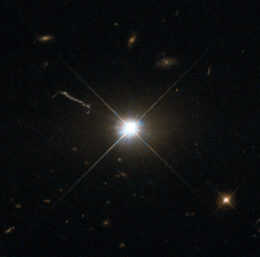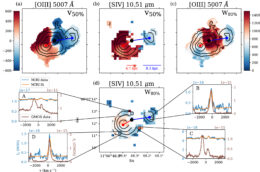Using JWST, researchers have validated a new tool for studying quasars — the extremely luminous nuclei of galaxies in the early universe, powered by the accretion of gas onto a growing supermassive black hole.
Studying Superlative Sources

This Hubble image shows the quasar 3C 273. [ESA/Hubble & NASA; CC BY 4.0]
Astronomers have identified the best optical wavelengths for studying quasar outflows, but with a powerful new infrared telescope in our toolkit, we’ll need to develop new diagnostics for studying these features in the infrared and measure how they stack up against our existing tools.
Visible vs. Infrared
To expand our toolkit into the infrared, David Rupke (Rhodes College) and collaborators compared infrared observations from JWST and visible-light observations from the Gemini North telescope. The team focused on the quasar F2M110648.35+480712.3, or F2M1106 for short, which at roughly 5 billion light-years away is the nearest of the quasars in the JWST Q3D Early Release Science program sample.
Rupke‘s team analyzed observations at two main wavelengths: visible light at 500 nanometers, which comes from oxygen atoms that have lost two of their electrons, and infrared light at 10.5 microns (1 micron = 10-6 meter), which comes from sulfur atoms that have lost three of their electrons. The 500-nanometer oxygen line is a proven tool for studying quasar outflows since it traces oxygen atoms that have lost their electrons to the harsh ultraviolet radiation from the quasar. Coincidentally, it takes nearly the same amount of energy to remove three electrons from a sulfur atom as it does to steal two electrons from an oxygen atom. This hints that the infrared sulfur line might trace the same structures that are traced by the oxygen line — namely, the warm, ionized gas that makes up a quasar’s powerful outflows.
Future Quasar Investigations

Comparison of emission from doubly ionized oxygen (OIII) at 500 nm/5007 Å to emission from triply ionized sulfur (SIV) at 10.51 microns. Click to enlarge. [Rupke et al. 2023]
While the two emission lines don’t paint exactly the same picture — the infrared sulfur line is inherently weaker than the optical oxygen line, so it fades out of view in certain regions — it’s clear that 10.5-micron emission is an effective way to study quasar outflows with JWST. And for dust-reddened quasars like F2M1106, it has a particular advantage, as its longer wavelength is better at piercing dusty clouds. This study demonstrates JWST’s potential as a new tool for studying quasar outflows, helping us to understand the impact of these structures on galaxy evolution.
Citation
“First Results from the JWST Early Release Science Program Q3D: Benchmark Comparison of Optical and Mid-infrared Tracers of a Dusty, Ionized Red Quasar Wind at z = 0.435,” David S. N. Rupke et al 2023 ApJL 953 L26. doi:10.3847/2041-8213/aced85

